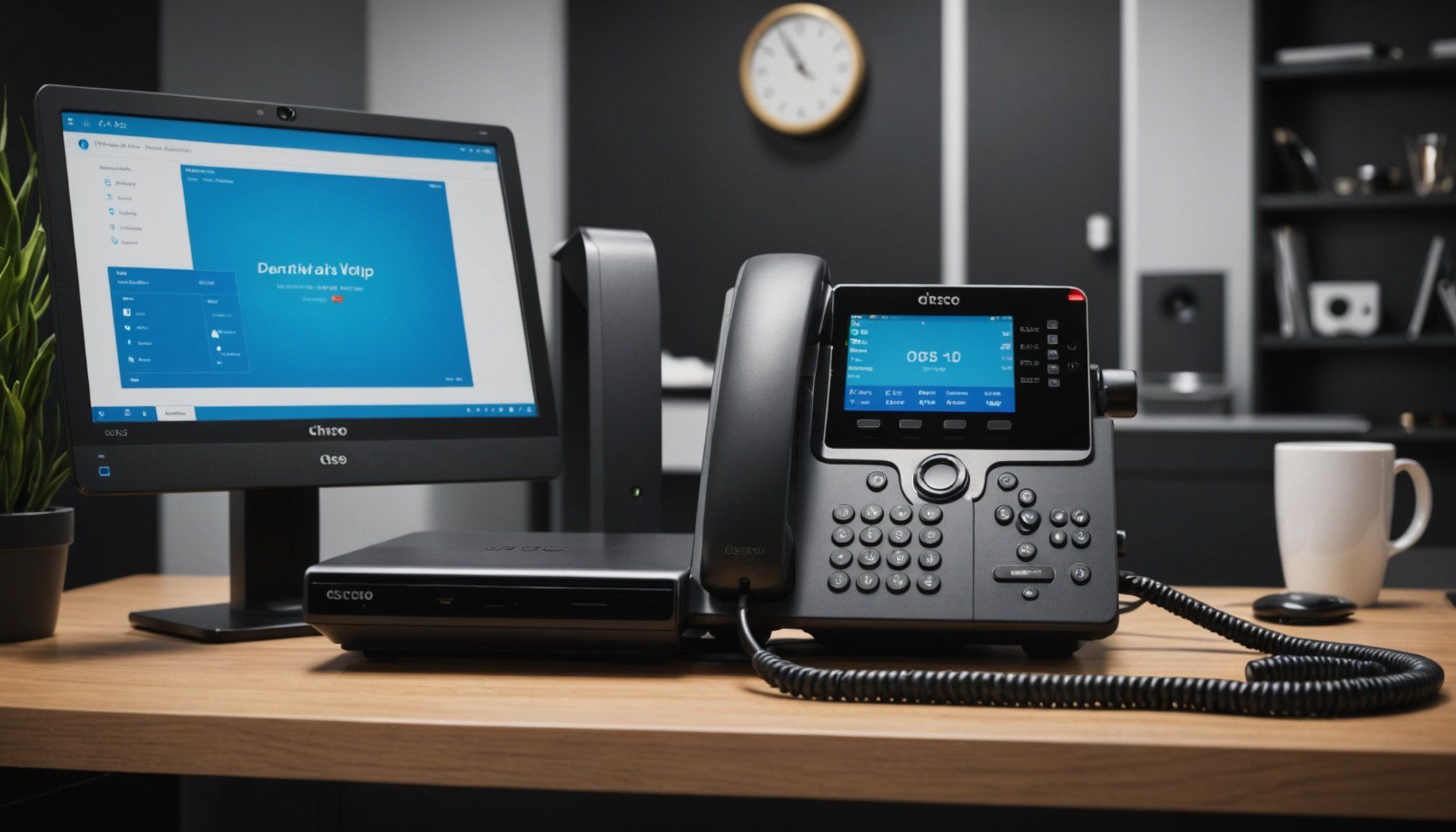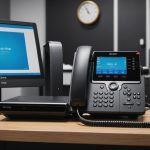Ultimate Guide to Configuring VoIP: Seamlessly Connect Cisco SPA112 with Synology NAS to VoIP and Its Importance
In today’s digital age, Voice over Internet Protocol (VoIP) has become an essential tool for both personal and business communications. VoIP allows you to make voice calls using your internet connection, offering flexibility, cost savings, and a range of advanced features. However, setting up a VoIP system can be complex, especially when integrating it with other devices like a Synology NAS and a Cisco SPA112 adapter. In this guide, we will walk you through the process of configuring your VoIP system to seamlessly connect these devices.
Understanding Your Devices
Before we dive into the configuration process, it’s crucial to understand the devices involved.
Topic to read : Establishing a Safe Remote Workspace: Top Tips Using Ubiquiti UniFi Dream Machine
Cisco SPA112
The Cisco SPA112 is a SIP (Session Initiation Protocol) adapter that allows you to connect your analog phone to your VoIP service. It supports two FXS (Foreign Exchange Station) ports, which can be used to connect two analog phones or fax machines.
Synology NAS
A Synology NAS (Network-Attached Storage) is a powerful storage solution that can also serve as a central hub for your home or business network. It can run various applications, including those related to VoIP, thanks to its DSM (DiskStation Manager) operating system.
Also read : Enhance Your Home Office Security: Proven Tactics with the Linksys MX5 Velop AX WiFi 6 System
Preparing Your Network
Setting Up Your Network Environment
To ensure a smooth setup, your network environment needs to be properly configured.
- Router Configuration: Ensure your router is configured to handle VoIP traffic. This may involve setting up Quality of Service (QoS) rules to prioritize VoIP packets and prevent jitter or latency[1].
- Firewall Settings: Configure your firewall to allow VoIP traffic. This typically involves opening specific ports (e.g., UDP 5060 for SIP) and enabling necessary protocols like RTP (Real-Time Transport Protocol)[5].
Ensuring Network Security
Network security is critical when setting up a VoIP system. Here are some key practices to follow:
- Use Strong Authentication Methods: Implement multi-factor authentication (MFA) to secure access to your VoIP accounts and devices[2][5].
- Regular Software Updates: Keep your VoIP software and firmware up to date to patch vulnerabilities and protect against malicious attacks[2][5].
- Encrypt VoIP Calls: Use protocols like SRTP (Secure Real-Time Transport Protocol) and TLS (Transport Layer Security) to encrypt your VoIP communications[4][5].
Extracting Configuration Details from Your ISP
If you are replacing an ISP-provided router with a neutral router and a Synology NAS, you may need to extract configuration details from your ISP’s router.
Steps to Extract Configuration Details
Here’s how you can extract the necessary configuration details using a tool like Wireshark:
- Connect to the ISP Router: Connect your computer to the LAN port of the ISP router.
- Reset the ISP Router: Reset the ISP router to its factory settings. This step is crucial for accessing the default admin credentials.
- Access the Router Configuration: Use the default admin credentials to access the router’s configuration menu. For example, for a Vodafone SerComm H500-S router, the credentials might be
adminandVF-ESVodafone-H500-s[1]. - Capture Configuration Details: Use Wireshark to capture the PPPoE credentials and other necessary configuration details. Filter the packets to find the relevant information, such as your phone number and PPPoE username and password[1].
Configuring the Cisco SPA112
Connecting the Cisco SPA112
To configure the Cisco SPA112, follow these steps:
- Physical Connection: Connect your analog phone to one of the FXS ports on the Cisco SPA112.
- Power On: Power on the Cisco SPA112 and ensure it is connected to your network via an Ethernet cable.
- Access the Web Interface: Open a web browser and navigate to the IP address of the Cisco SPA112 (usually
192.168.0.1or similar). Log in with the default admin credentials (typicallyadminfor both username and password).
Configuring VoIP Settings
Here’s how to configure the VoIP settings on the Cisco SPA112:
- SIP Settings: Enter the SIP server details provided by your VoIP service provider. This includes the SIP server IP, username, and password.
- Dial Plan: Configure the dial plan to ensure proper call routing.
- Voice Quality: Adjust settings for voice quality, such as jitter buffer and packet size, to optimize your call experience.
Example of SIP Settings:
- SIP Server: sip.example.com
- Username: yourusername
- Password: yourpassword
Integrating with Synology NAS
Installing Necessary Packages
To integrate your VoIP system with your Synology NAS, you may need to install specific packages.
- Asterisk or FreePBX: These are popular VoIP server software that can be installed on your Synology NAS. They provide a comprehensive set of features for managing your VoIP system[4].
Configuring the NAS for VoIP
- Create a VLAN: If you are using a VLAN for your VoIP traffic, configure it on your Synology NAS. This involves creating a VLAN ID and assigning it to the appropriate network interface[1].
- Port Forwarding: Set up port forwarding rules on your NAS to direct VoIP traffic to the Cisco SPA112.
- Firewall Configuration: Ensure the firewall on your NAS is configured to allow VoIP traffic. This includes opening necessary ports and enabling protocols like SIP and RTP[5].
Ensuring Security and Performance
Real-Time Monitoring
Regularly monitor your VoIP traffic for suspicious activity. This can include monitoring call volumes, packet loss, and latency to ensure network integrity.
Key Metrics to Monitor:
- Call Volume
- Packet Loss
- Latency
- Jitter
Encryption and Authentication
Ensure that all VoIP communications are encrypted using protocols like SRTP and TLS. Implement strong authentication methods such as MFA to secure access to your VoIP accounts and devices[2][4][5].
Practical Tips and Examples
Example Configuration for a Home Office
Here’s an example of how you might configure your VoIP system for a home office:
- Network Setup: Use a Synology NAS as the central hub, connected to a router that prioritizes VoIP traffic.
- Cisco SPA112: Connect the Cisco SPA112 to the router and configure it with your VoIP service provider’s SIP settings.
- Analog Phone: Connect an analog phone to the Cisco SPA112 and ensure it is working correctly.
Common Issues and Solutions
Here are some common issues you might encounter and how to solve them:
- Poor Voice Quality: Adjust the jitter buffer and packet size settings on the Cisco SPA112 to optimize voice quality.
- Connection Drops: Ensure that the QoS settings on your router are correctly configured to prioritize VoIP traffic.
- Security Breaches: Regularly update your VoIP software and firmware, and use strong encryption protocols to protect against malicious attacks.
Configuring a VoIP system to seamlessly connect with a Cisco SPA112 and a Synology NAS requires careful planning and execution. By following the steps outlined in this guide, you can ensure a secure, high-performance VoIP setup that meets your communication needs.
Key Takeaways
- Network Preparation: Ensure your network environment is properly configured to handle VoIP traffic.
- Device Configuration: Correctly configure the Cisco SPA112 and Synology NAS for VoIP.
- Security Measures: Implement strong security measures, including encryption and authentication.
- Real-Time Monitoring: Regularly monitor your VoIP traffic to ensure network integrity.
By adhering to these guidelines, you can enjoy reliable, secure, and high-quality VoIP communications, whether you’re using your system for personal calls, business meetings, or even smart home integrations.
Additional Resources
For further reading and to stay updated on the latest in VoIP security and configuration:
- LG Talk: VoIP Cybersecurity in the Holiday Season[2]
- TechRepublic: VoIP Security and Encryption[4]
- Microminder Cybersecurity: VoIP Network Security[5]
These resources provide in-depth information on best practices for VoIP security, encryption methods, and how to protect your system from malicious attacks.











